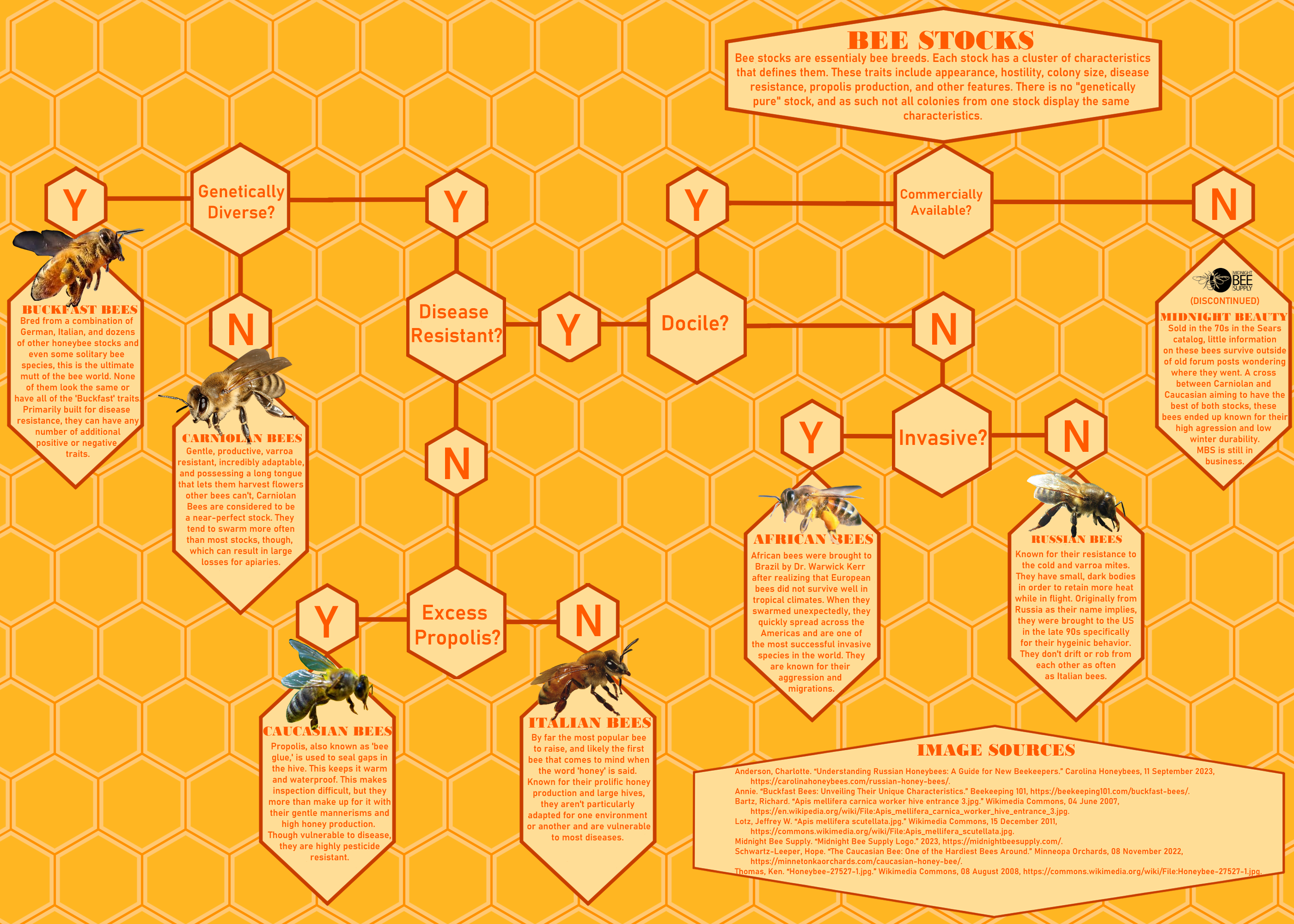click image to see full view

Miscellaneous
I made this flow chart for an English project in college about identifying different types of bee stocks. Before I get into talking about this, though, I'd like to make one correction to this chart: Midnight Bee Supply was not the inventor of the Midnight Beauty line of bees, more commonly referred to as Midnite Bees. That was actually Dadant and Sons, but it took me a literal year to finally find this out. Additionally, Midnite bees were only aggressive in their second generation of queens, while the first gen was docile enough to be held. This happens a lot with hybrids. This is the chart I turned in for the assignment unaltered. I no longer have the original file to fix it, however if for some reason you wanted to use this chart in your project I would be happy to update it for you. Now I shall talk about the specifics. Most of the information you need about the bees themselves is on the chart, so I will instead talk about my year-long obsession with discontinued bee stocks. This chart was for my second semester in college, and I had been given free reign as far as the topics of my papers as long as I completed the requirements of the projects. I mostly wrote about urban beekeeping and how to handle varroa mites. While researching varroa mites I learned that Italian bees are not the only honeybee species out there. I knew about African honeybees and their aggressive hybrid children, but the world of Russian bees and German/black bees etc etc was entirely new to me. It felt very similar to discovering that there was a difference between the tissues in your body. I ended up on a lot of bee forums, and thus did I encounter Starline and Midnight Beauty bee stocks. I was enamoured immediately. Discontinued hybrids with such beautiful names that were specifically sold in Sears catalogs only to disappear felt like an ARG made specifically to appeal to me. I couldn't spend as much time looking for information on them as I wanted, though, and it seemed that the internet wished to hide the fact these bees existed at all from me as much as possible. My search history was full of differently worded versions of the question "who invented midnight bees," and each time I got a different answer. Since Midnight Bee Supply came up the most when I searched anything with the phrase 'midnight bees' and they were named Midnight Bee Supply, I incorrectly assumed that Midnight Bee Supply came up with them. I wasn't able to look into Starline as much because I had decided I needed to focus on one or I wouldn't get anything done. The next semester I was in a Technology and Society class and once more given basically free reign as far as my research went. I wrote a paper on different domestic hive styles, but I also got the golden opportunity I had been waiting for so long: one of our papers was about the Sears catalog. Finally I had free reign to go all in on my hunt for the origin of Midnight Bees. I sat in the professor's room after class and flipped frantically through the physical catalog he had brought in for us for any trace of Midnight bees, only to be told it was in the Sears Farm and Ranch catalog. You could order Italian bees as well. I found a database of Sears catalogs on the internet and scoured every single Farm and Ranch edition for even a passing mention of Midnight Bees. In the end, the only listing I was able to find had been dug up by someone else looking for the same thing I was, which I will link below. It was my lifeline. I clung to the scan this one page with all I had, looking over and over for any indication as to which company was providing the damn things. I expressed my madness to my mother, rambling on and on about how entire species of hybrid honey bees had just disappeared because of how expensive they were to produce and how unreliable they tended to be. My mother then found the answer to my burning question with literally one Google search. A literal year of obsessive searching, scouring forums for even passing mentions of Midnight bees and looking through old scans and borderline setting up a pinboard with red string, and my mother found it in five minutes. It broke me, but I was happy to put the question to rest and finally bring an answer to my technology professor, who I had dragged into my madness by constantly updating him about my search while reading every page of his catalogs. The worst part was Midnight Bees had exactly a one-sentence mention in the Dadant and Sons history page, along with Starline bees. Since this obsession had basically ruined my life for a few months I decided it was best I didn't deep dive into other hybrid species. I decided to be content with what I knew, and to focus on learning things that would actually help me in my desire to be an entomologist instead of getting hung up on mysteries no matter how enticing they were. That said, I still engage heavily with ARGs when I can. I just don't do it during school hours.
Dadant and Sons history page Catalog Blog page about Midnight Beauty bees Musetechnical Sears Catalog Scan Database